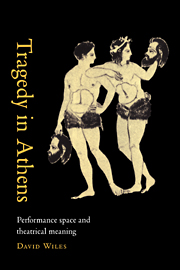Book contents
- Frontmatter
- Contents
- List of illustrations
- Acknowledgements
- List of abbreviations
- 1 The problem of space
- 2 The Theatre of Dionysus
- 3 Focus on the centre point
- 4 The mimetic action of the chorus
- 5 The chorus: its transformation of space
- 6 Left and right, east and west
- 7 Inside/outside
- 8 The vertical axis
- 9 The iconography of sacred space
- 10 Orchêstra and theatron
- Select bibliography
- Index
6 - Left and right, east and west
Published online by Cambridge University Press: 06 January 2010
- Frontmatter
- Contents
- List of illustrations
- Acknowledgements
- List of abbreviations
- 1 The problem of space
- 2 The Theatre of Dionysus
- 3 Focus on the centre point
- 4 The mimetic action of the chorus
- 5 The chorus: its transformation of space
- 6 Left and right, east and west
- 7 Inside/outside
- 8 The vertical axis
- 9 The iconography of sacred space
- 10 Orchêstra and theatron
- Select bibliography
- Index
Summary
‘The setting of The Women of Trachis is the patch of ground in front of Heracles’ borrowed house near Trachis'. Any such formulation might sound precise but is in fact deeply misleading because it is couched in the language of realism. To set up a semiotic distinction, in the manner of Issacharoff, between the ‘mimetic’ space of the Trachian house and ‘diegetic’ spaces like Hades is unhelpful, for at a certain point in the first choral ode the skênê doors signify Hades. We need a critical language that does not turn upon a reductive notion of mimesis. We might more usefully say, in Gombrich's terms, that Sophocles like any artist uses and adapts received schemata. We might seek to understand the representational space created by Sophocles in Lefebvre's terms, in relation to a socially constituted spatial practice. We could say, in Lotman's terms, that Sophocles in his plays ‘models’ the universe. If we start from premisses of this kind, then we shall find it impossible to relate to a single imagined referent the image that meets the spectator's eye. It will be more helpful to see the moving visual image as a structure, grid or geometric model.
The easiest way to analyse such a structure, following Saussure, Lotman and Ubersfeld, is in terms of binary oppositions. In chapter 8 I will examine the importance of the vertical axis in Greek performance. However, for an audience gazing downwards from high above the acting space, it is predominantly upon the horizontal plane that theatrical signs need to be organized.
- Type
- Chapter
- Information
- Tragedy in AthensPerformance Space and Theatrical Meaning, pp. 133 - 160Publisher: Cambridge University PressPrint publication year: 1997
- 2
- Cited by



